All that separated months of planning and anticipation from our biggest lifer was the chasm of a few hours of restless sleep. Finally, after multiple disappointing checks of the clock through the night, 3:00 was here. It was go time! As is usually the case for big events like this, Evan was easy to wake up. Before long the three of us were out of the house and at our rendezvous point with John Carlson and Charlie Eustace on the north side of Billings.
It was a nice addition to have dad’s former colleague, Charlie, along with us. Since Charlie had obligations later that day, he drove separately up to Lavina. Dad seized the opportunity to catch up with his old friend and fellow biologist by hopping in with Charlie. Meanwhile, Evan and I rode up with John for the 45-minute ride in the darkness. Evan dozed in and out of sleep, but John and I were wide awake and excitedly talking birds, amped up by the adventure that was about to happen. In no time, we were at Lavina where we picked up Dad and Charlie. In minutes we were off the tar and on East Red Hill Road which would take us to the lek that John had selected for us. As John drove through the desolate sagebrush country in the dark, Charlie entertained us with one more story from Dad’s former days with the Fish & Game Department. I knew that cell phone technology originated in the 70s, but what I did not know was that Dad had one of the first ones. He used it to call into field offices when he was out doing research. According to Charlie, Dad was only the second person in Montana who had a cell phone at the time. When the other person, the *ahem* Governor, found out he did not have exclusive rights to this cutting-edge technology and that a lowly field biologist also had a cell phone, the governor’s ego was greatly bruised. And as a result, my dad, like so many students in my classroom over the years, got his phone taken away. Charlie laughed and laughed (and so did we) as he told the story.
Don’t ask me how, but John eventually discerned our stopping point in the darkness along East Red Rill Road. He confirmed the location by checking his GPS. Many life birds are happenstance. Many are searched for and sought out. This one was pinpointed down to the degree, minute, and second–a field technician that works under John had placed a blind in the optimal viewing location for the lek and then given John the coordinates. John took off walking into the black, sagebrush abyss armed only with a headlamp and his GPS. John still had to set up the blind that was waiting for us somewhere out in the middle of nowhere. As he walked, we could hear him flushing Sage-Grouse off the lek, which he told us would happen. I’ve flushed many, many gamebirds over the years, but I could tell that these sounded different. They sounded bigger.
The rest of us gathered our things and then went in the direction of John’s headlamp. Setting out into utter darkness distorts the perception of distance. It felt like we had walked a mile, but in reality it was probably a quarter mile or so. I’ll never forget taking a look back to the east where the sun was still well below the horizon but already showing the contours of the hills as a bright orange line that stretched as far as you could see. Even in the darkness, you could tell we were in Big Sky country.
We eventually made it out to John who was finishing setting up the blind which is no easy task under optimal conditions, let alone when it’s dark and there is a strong wind. Once we were out there, we realized that we were a couple chairs short, so I went back to John’s Suburban to get more. On my hike back, I flushed about a dozen Sage-Grouse. All were heard-only flushes until three birds flushed in front of me giving me my life look as large, long-tailed silhouettes illuminated by the orange glow to the east. Awesome. Once I made it back to the blind, the task was now to get the four of us inside. John opted to go view a different lek since we couldn’t all fit in the blind. None of us knew where the door was or how it operated, so everybody shimmied underneath the walls to get inside. Only afterward in the daylight hours did I realize there were cacti all over the place. But the four of us eventually got inside and got situated as best we could as human sardines.
Once the rustling stopped and we all could sit still, it didn’t take long to hear the popping sound of the Sage-Grouse doing their crazy, head-bobbing, air-sac pumping display. It is an eery sound that could be heard all around us. I never realized until just a year ago that they did this dynamic motion and made this unearthly noise. Utter darkness slowly transitioned into a dimly lit landscape finally allowing us to see monstrous blobs on the landscape. And they were close. Eventually we could make out the large, white collars of the birds and see them as they thrust their heads while popping out their two large, yellow air-sacs. Evan and I had the front row and were excitedly looking to see more and more birds being revealed as the light began turning silhouettes into our target. It was so cool to finally be here, seeing this bird, and seeing it in just this way with just the right company. Here is the first photo that I took, which was quite awhile after we had started seeing and hearing the birds. It gives you a sense of the mystique of seeing these incredible birds when it is just light enough to discern your own hands out of the darkness.
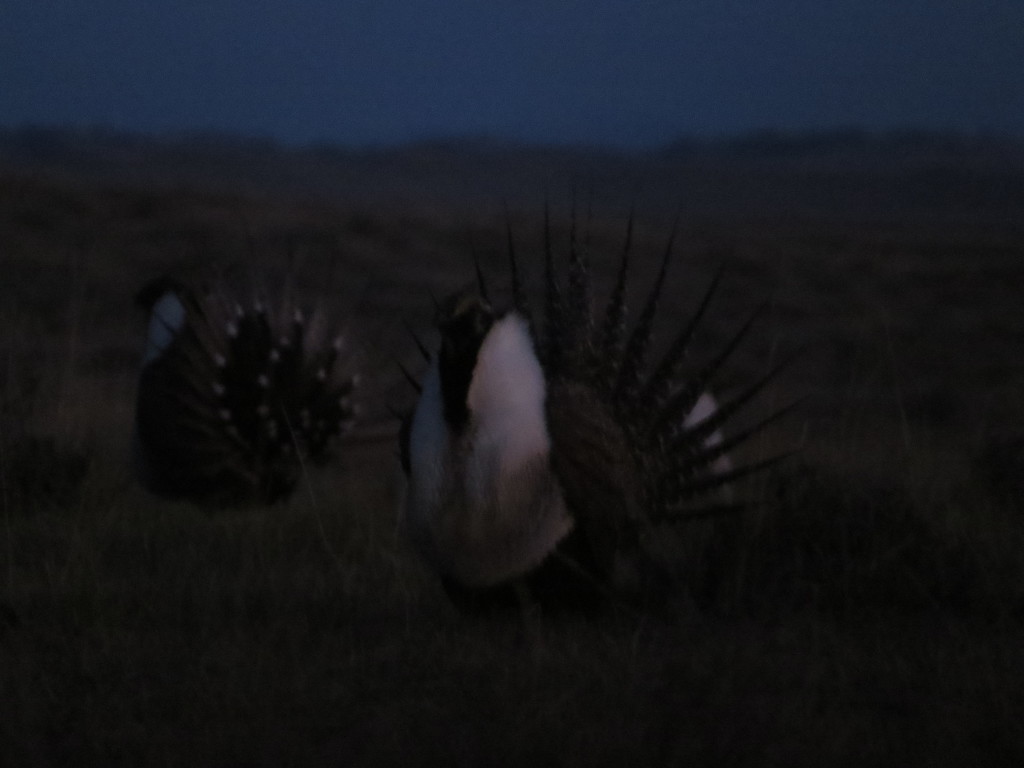 Even though the sun wasn’t up high enough for good photos, we were fascinated by what was going on all around us. Not only did we have roughly 30 males in front of us, but we could hear another large group of Sage-Grouse behind us–right where we had walked through. Sunrise was still a ways off, but the light was finally good enough to get some pictures.
Even though the sun wasn’t up high enough for good photos, we were fascinated by what was going on all around us. Not only did we have roughly 30 males in front of us, but we could hear another large group of Sage-Grouse behind us–right where we had walked through. Sunrise was still a ways off, but the light was finally good enough to get some pictures.
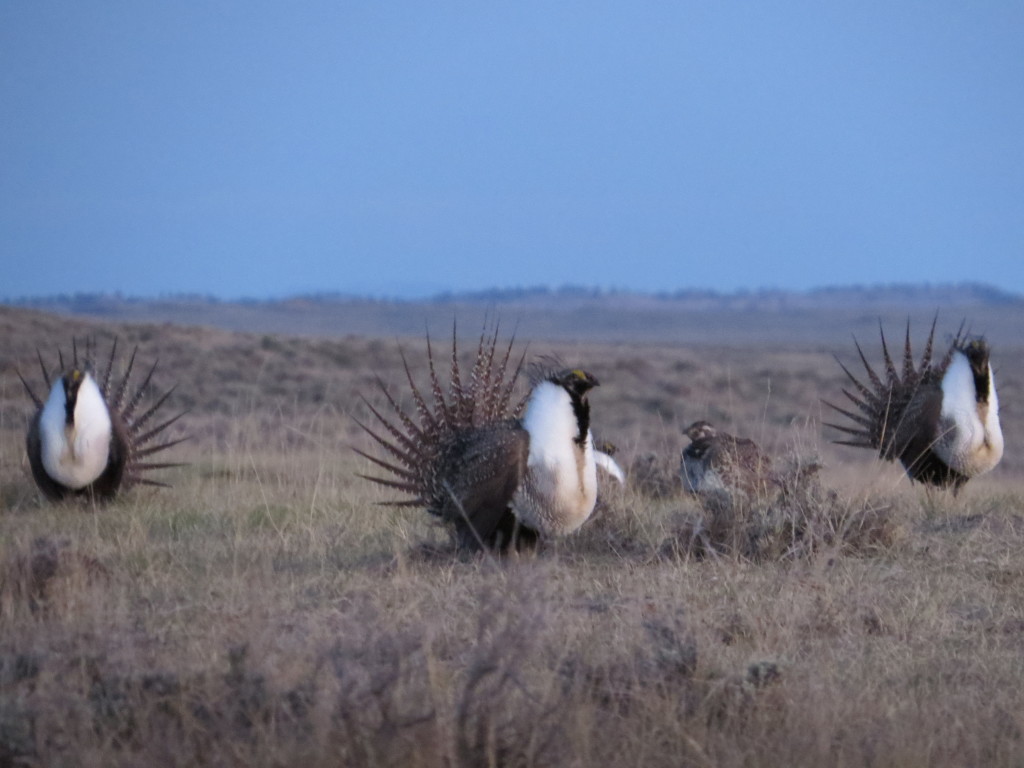
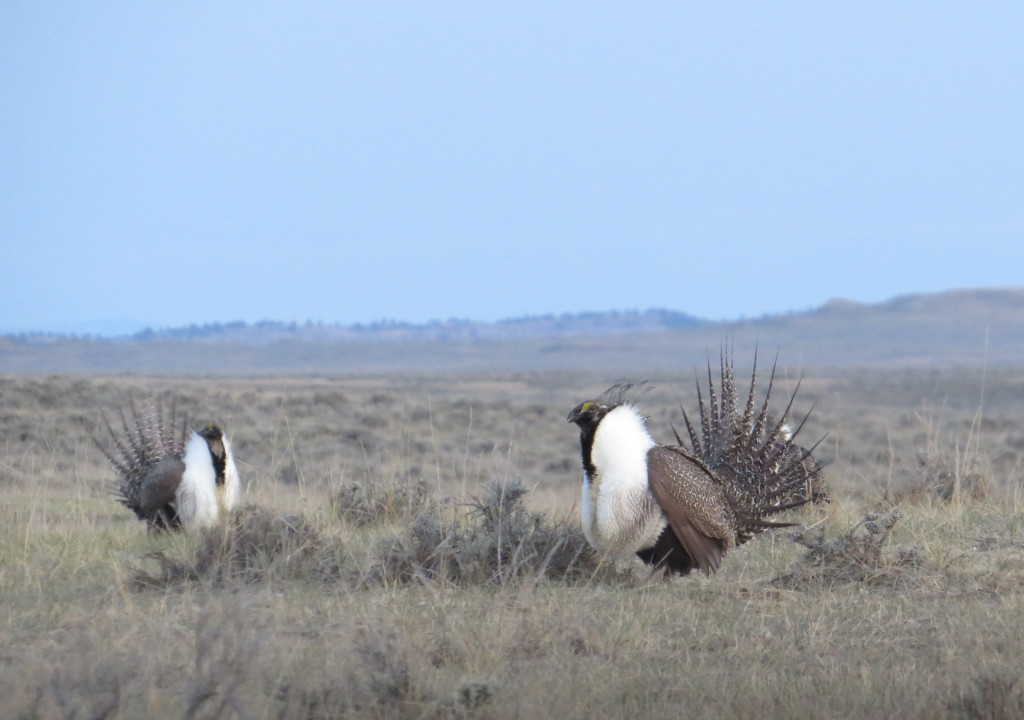
John told us that the black, hair-like feathers at the back of the neck are called filoplumes.
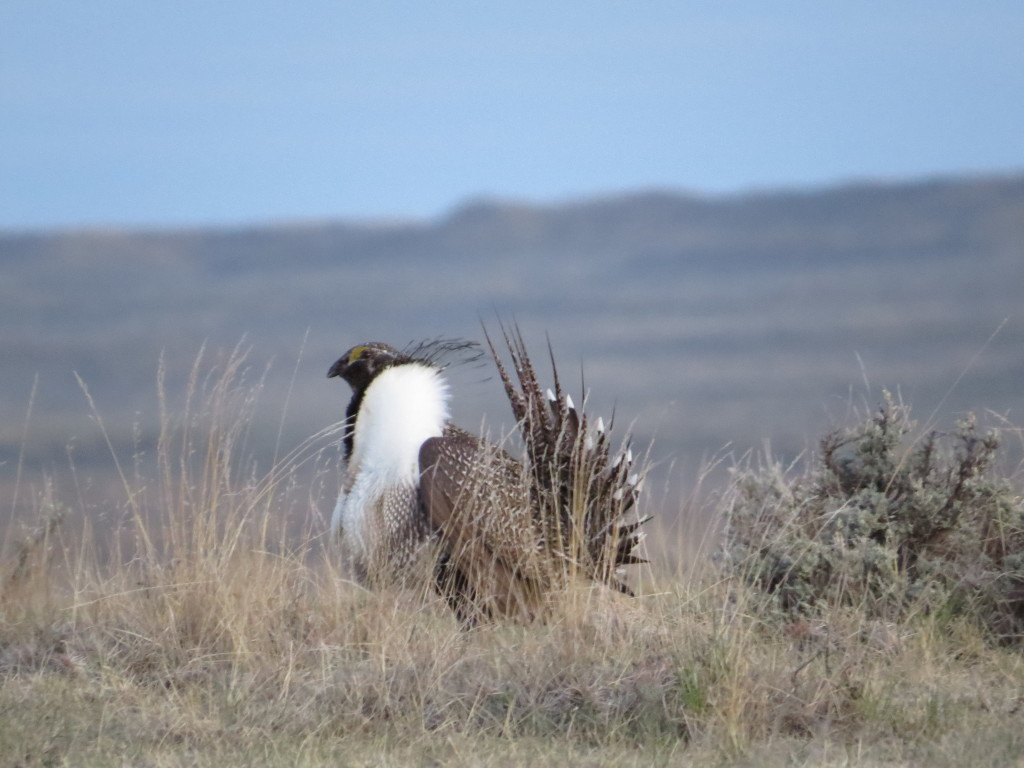
The Snowy Mountains which were living up to their namesake on this day made a nice backdrop for watching displaying Greater Sage-Grouse.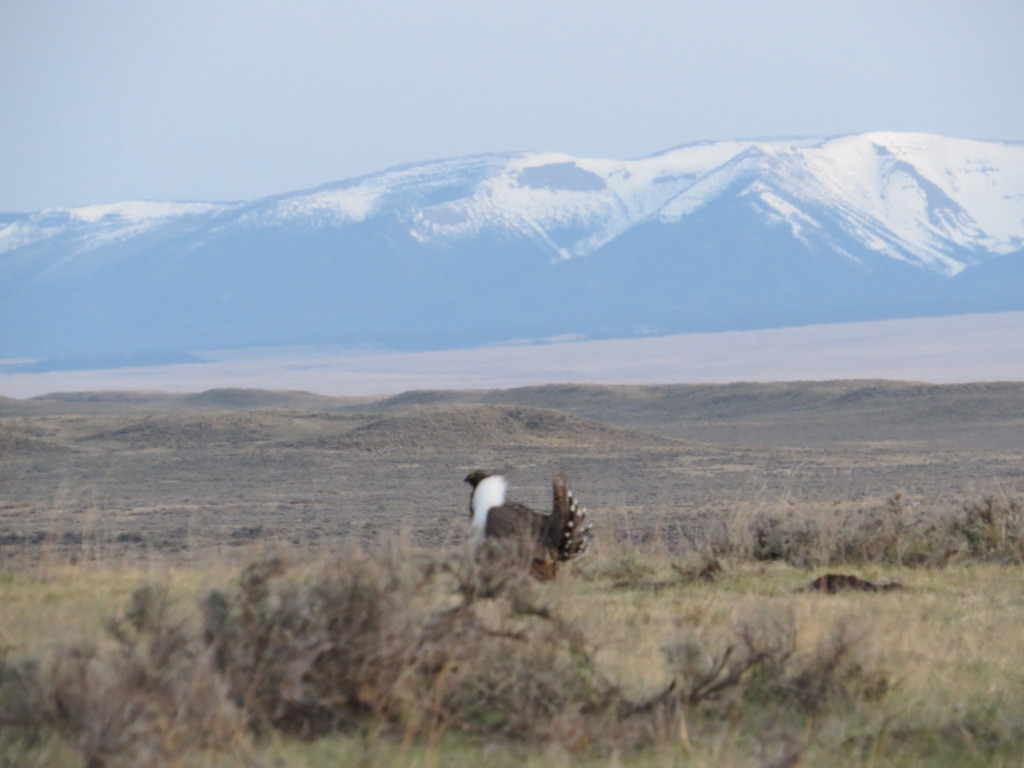 The birds pictured above were all fairly close in front of us, to the west and north. Behind us to the southeast we could finally make out the more distant birds as the light increased. This group was close to 40 birds! Here you can see how the Sage-Grouse choose a flat area with no sagebrush for their courtship display.
The birds pictured above were all fairly close in front of us, to the west and north. Behind us to the southeast we could finally make out the more distant birds as the light increased. This group was close to 40 birds! Here you can see how the Sage-Grouse choose a flat area with no sagebrush for their courtship display.
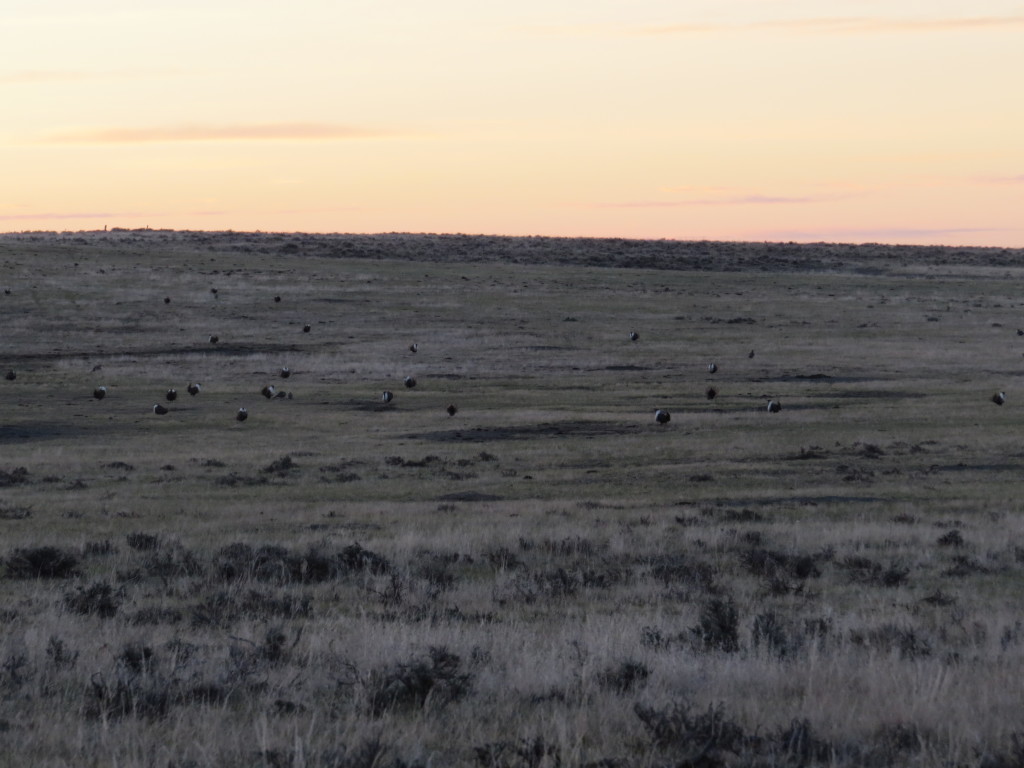 Dad told us that, despite all these males, only one or two will mate with all the hens. They are competing and working their hardest to be that stud. The group of hens will work their way onto the lek and then choose the candidate with the best genetic makeup, determined by whomever puts on the best display. Below you can see two hens sitting by the stud of this lek. Dad, being the biologist he is, was not entranced and distracted like we were by the myriad of males simultaneously doing their strut all around us. Instead he knew what to look for and was watching intently through his binoculars for copulation which he saw and then announced to the rest of us.
Dad told us that, despite all these males, only one or two will mate with all the hens. They are competing and working their hardest to be that stud. The group of hens will work their way onto the lek and then choose the candidate with the best genetic makeup, determined by whomever puts on the best display. Below you can see two hens sitting by the stud of this lek. Dad, being the biologist he is, was not entranced and distracted like we were by the myriad of males simultaneously doing their strut all around us. Instead he knew what to look for and was watching intently through his binoculars for copulation which he saw and then announced to the rest of us.
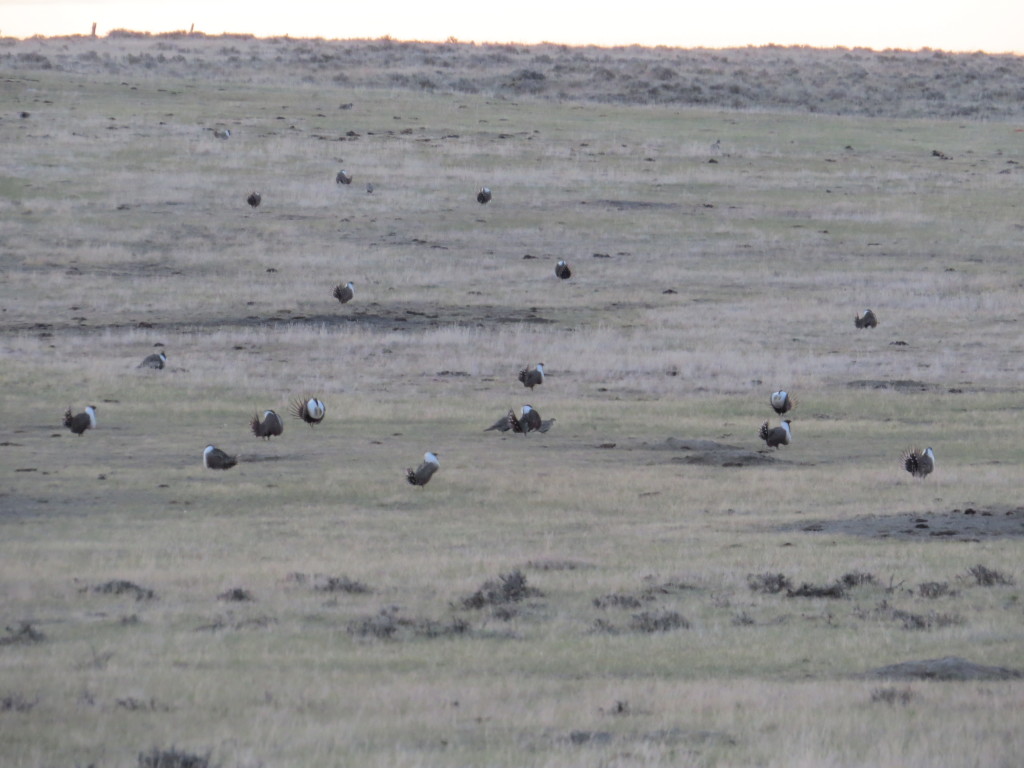
You will see this later in the video at the end of this post, but these males do their air-sac pumping display, pivot, and then do it over again in a different direction. Undoubtedly they are broadcasting their sound in all directions in an effort to attract the attention of the hens. If you compare the above photo to the photo below taken just a couple seconds later, you will see how some of the males are facing a new direction. You will also see birds at different stages in the very rapid air-sac pumping display.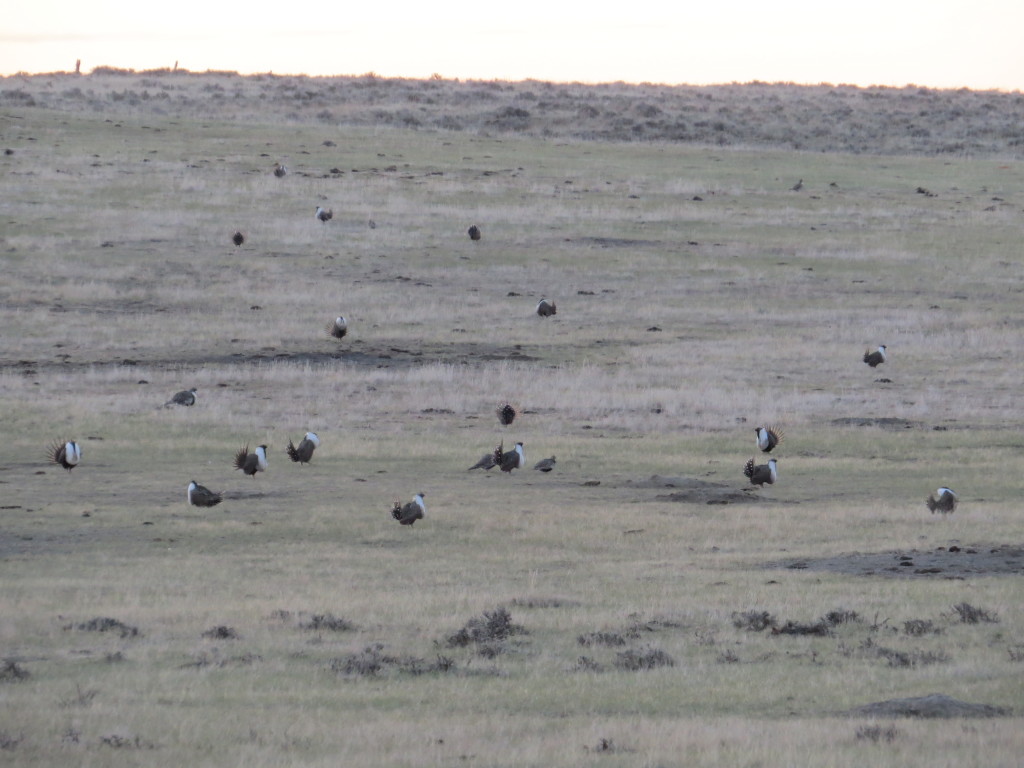
Dad taught us how the birds on the periphery of the main strutting area are the juvenile birds. In fact, some of these juveniles are relegated to do their strutting off the lek in the most undesirable of all places, the sagebrush itself. Occasionally one of these young bucks would test his mettle and wander through the main part of the strutting ground only to be chased off by the big boys. This never failed to elicit laughter from Dad and Charlie. It was fascinating to observe all these things Dad has talked about for years which were fairly abstract concepts to us until this point.
In addition to watching the courtship and mating antics, photography was also a priority for me, so I turned my attention back to the closer birds and eagerly awaited the sun to peak over the horizon. That didn’t stop me from photographing as I waited, though. This photo was as close as I got to capturing the split-second where the air-sacs are fully deployed.
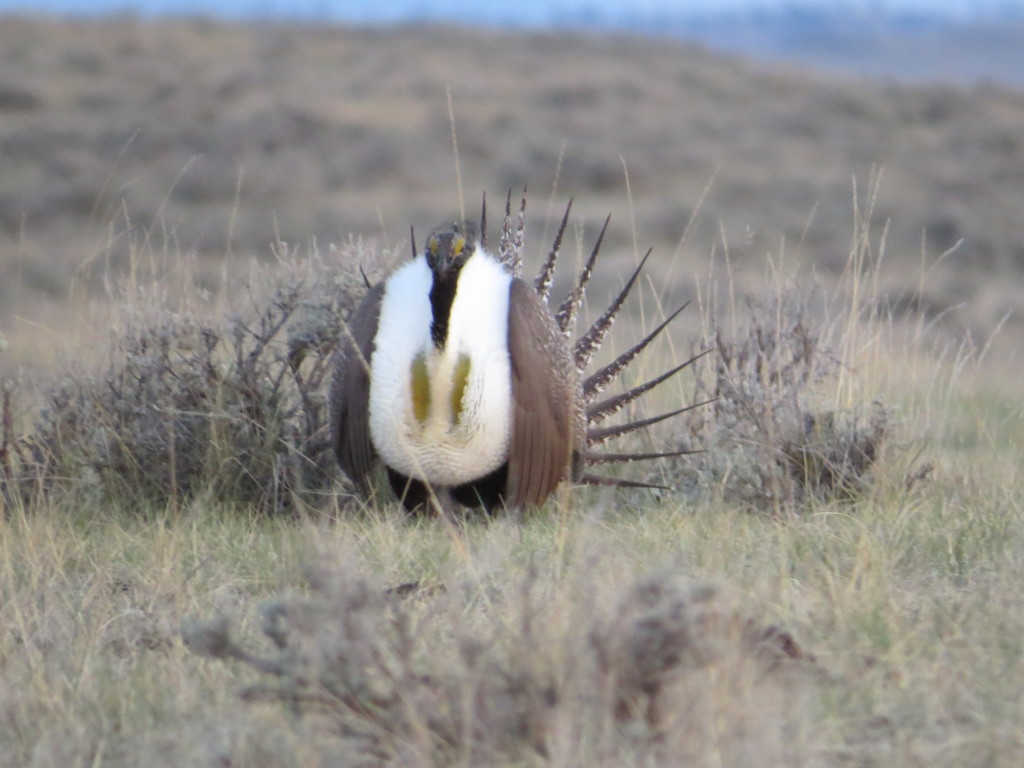
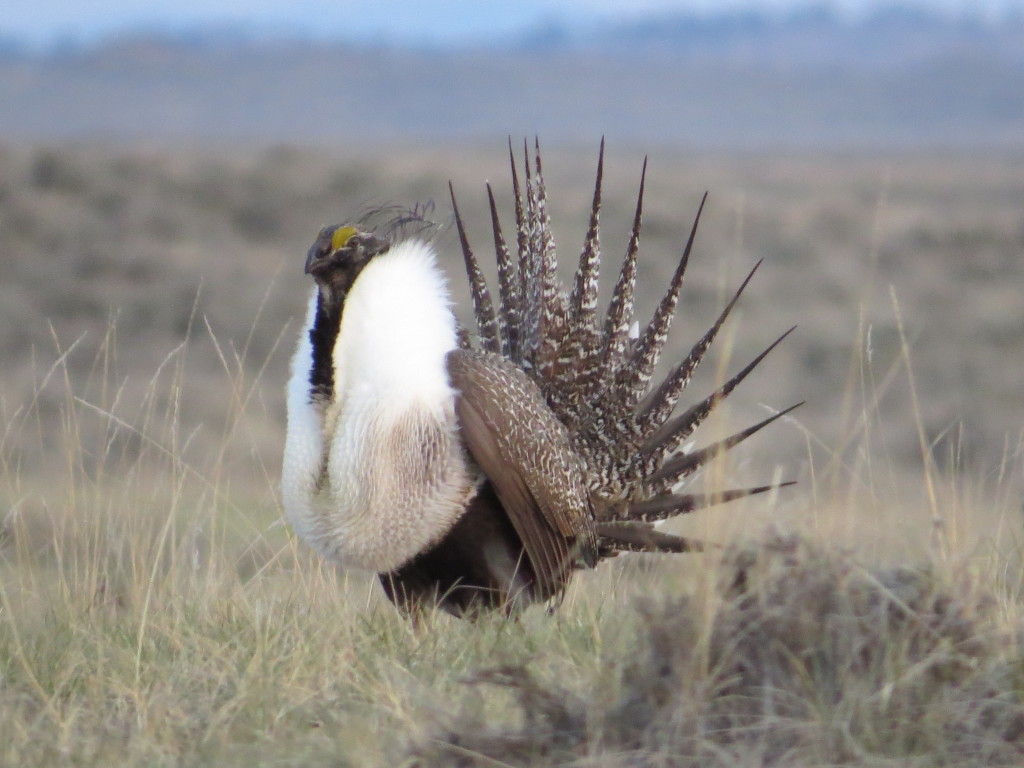
I was eager to get the photo above in the perfect morning sun which was coming in just a couple minutes. That wasn’t in the cards, though. Dad and Charlie started discussing what we’d do in the cramped blind if someone had to relieve himself. Then, after months of planning and careful preparation, I realized I made a fateful mistake: I did not make sure Evan went to the bathroom that morning. All the talk of waterworks was enough for Evan to realize this now too. I told him to quietly slip under the back corner of the blind (we still hadn’t found the door) so the close birds wouldn’t spook. When he was successfully out without flushing any Grouse, I whispered for him to go right next to the blind so he was still out of view of the birds. Well, he didn’t understand what I was saying and tromped out about 15 feet. That was it. The birds got out of there in a hurry.
Hope was not gone, though, as the two most prominent males held their ground. There were girls on the line, after all, or so they thought. Their thunder was gone, though, as they slowly started to realize there were no females to impress and no young whipper-snappers to beat off their turf. There was nothing to get pumped up for–literally or figuratively.
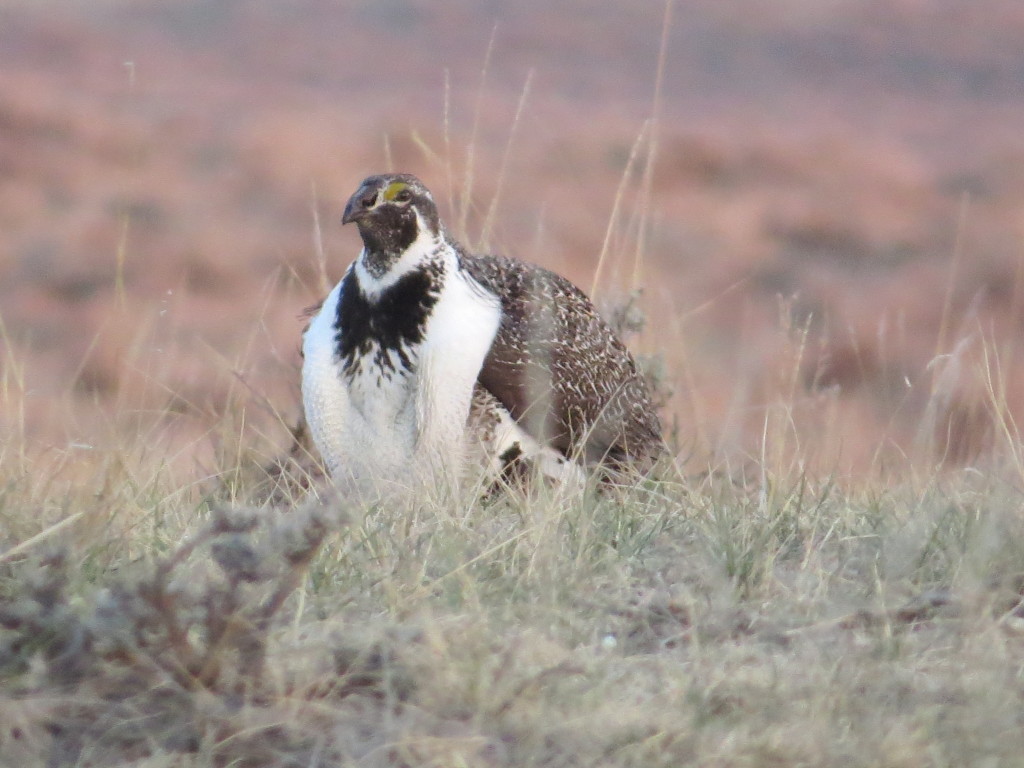
They instead mailed it in and pretended to still care by doing a non-threatening stand-off– in perfect light.
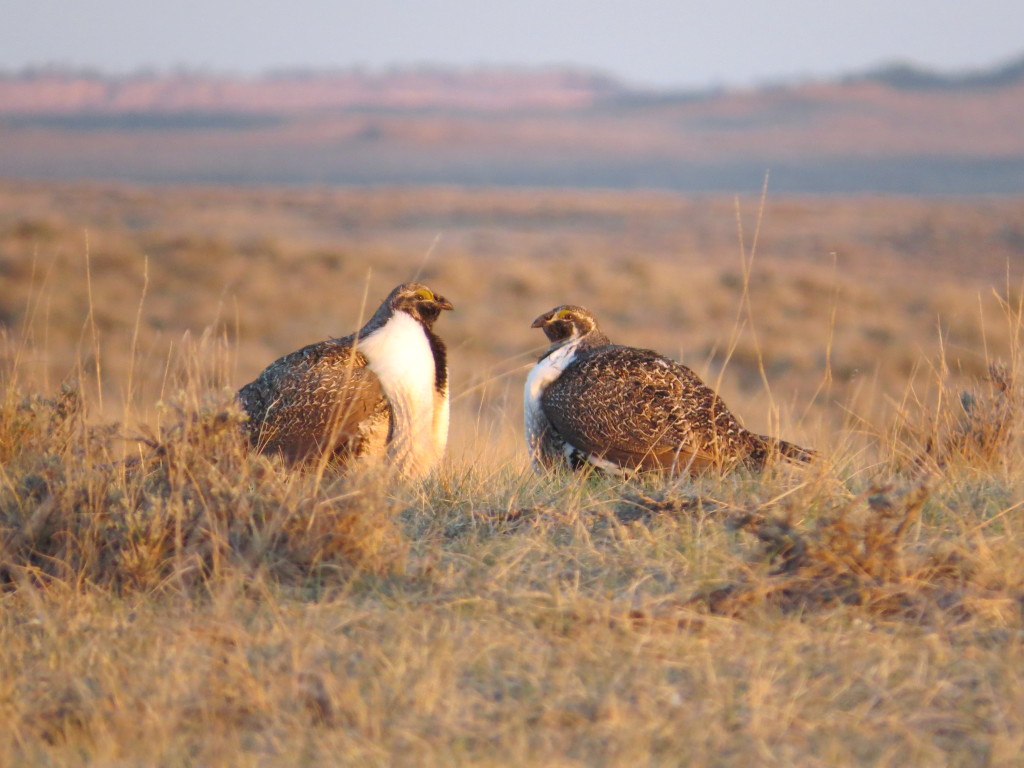
It turns out that Evan just accelerated what would have happened naturally anyway. Moments after this picture was taken, a Golden Eagle came in low and scared these two birds off also.
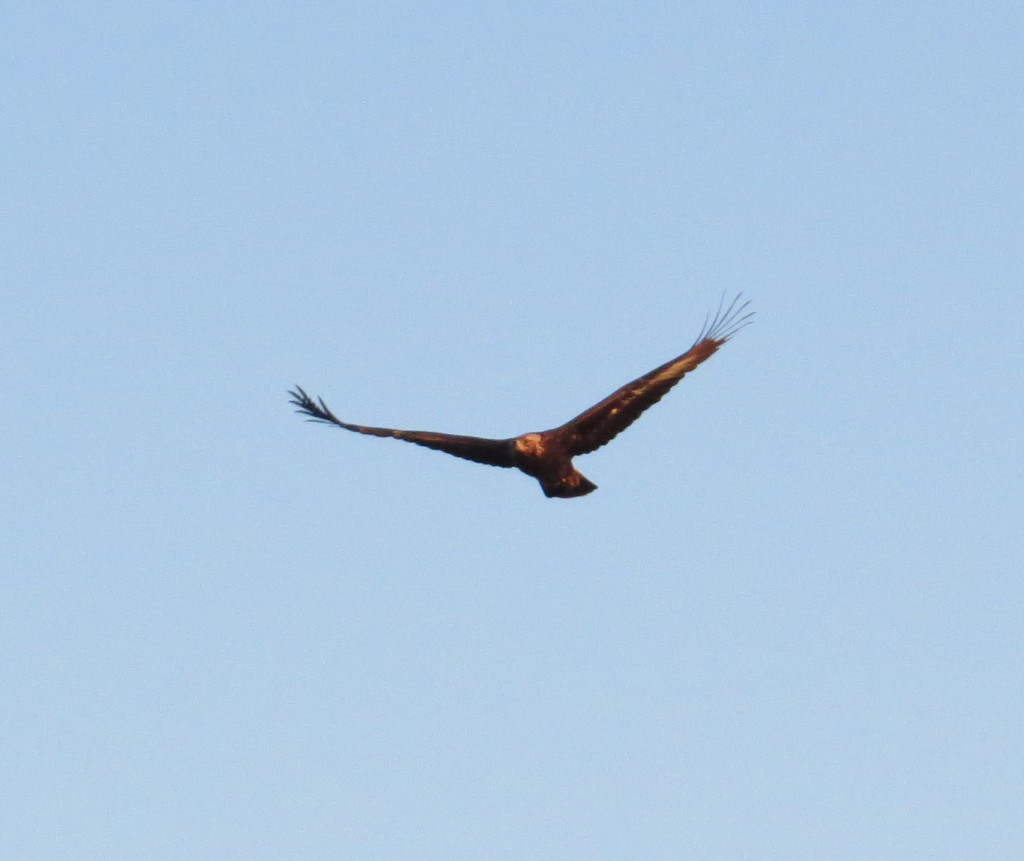
The Eagle then flew directly over the blind just 30 feet up, giving us our best looks ever at this species. I could see the golden nape with my naked eye. We watched out the back window of the blind as the Eagle proceeded to fly over the larger group of Sage-Grouse to our rear. Instantly they all took off, and the show was completely over. The time of day was 7:00.
I called up John so he could come and get us. We had a good 15 minutes to wait for him to show up, so we packed up the blind and chairs and started trekking back to East Red Hill Road.
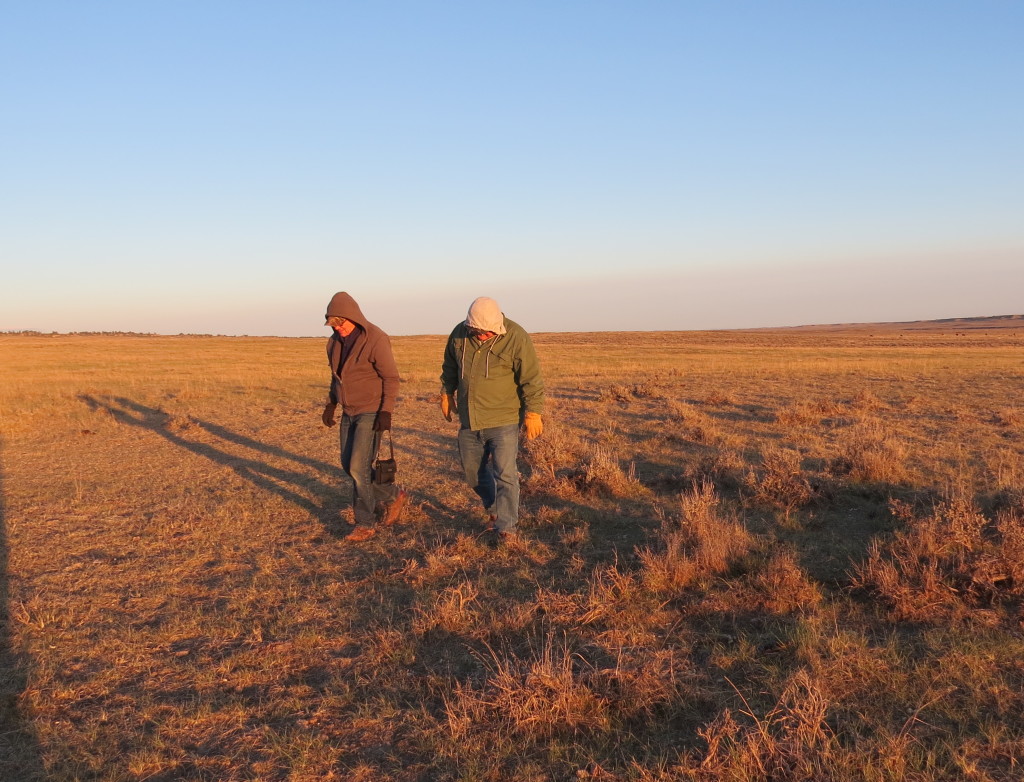
L-R: Charlie and Dad
It was a fast, intense morning and much shorter than I hoped. For Dad it was probably just about right. Having seen this bird and this courtship display many times he had said that viewing Sage-Grouse from a blind for a few hours might be overkill. I disagree, but then again, I also haven’t spent as many cold, dark mornings in the sagebrush-covered landscape as he has! But for me, there’s not enough sagebrush or its Grouse in my life.
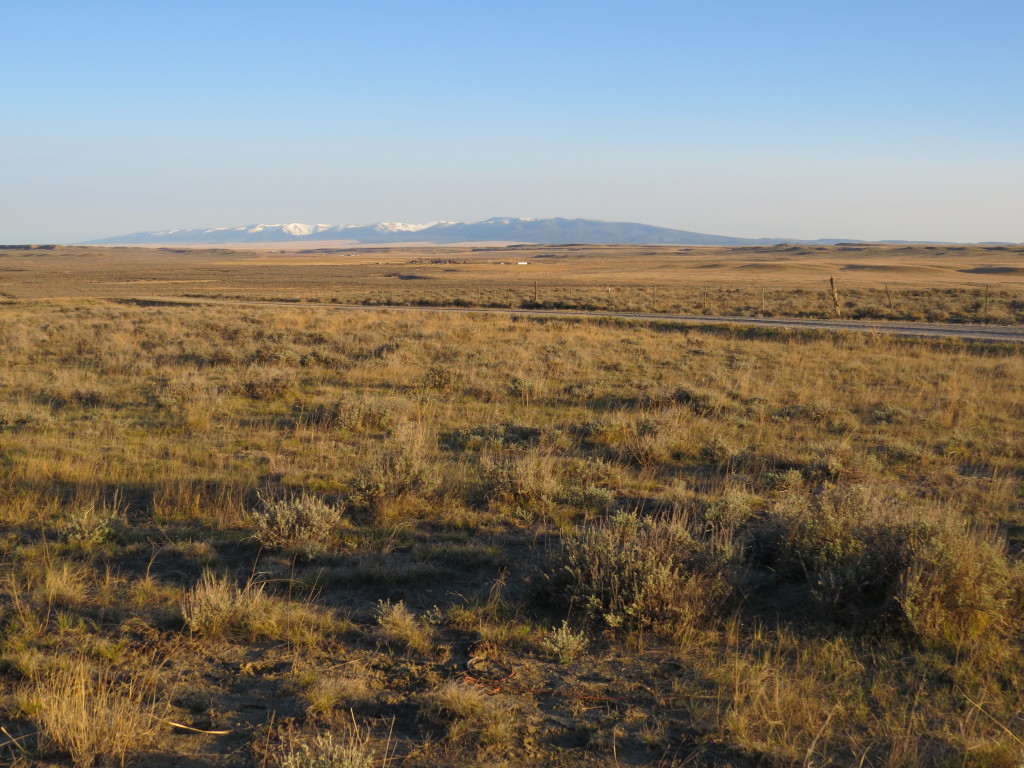
Once John arrived, we took some time for some group shots to commemorate the morning’s outing. In the distance we could hear male Sage-Grouse firing it up again in the places to which they had dispersed.
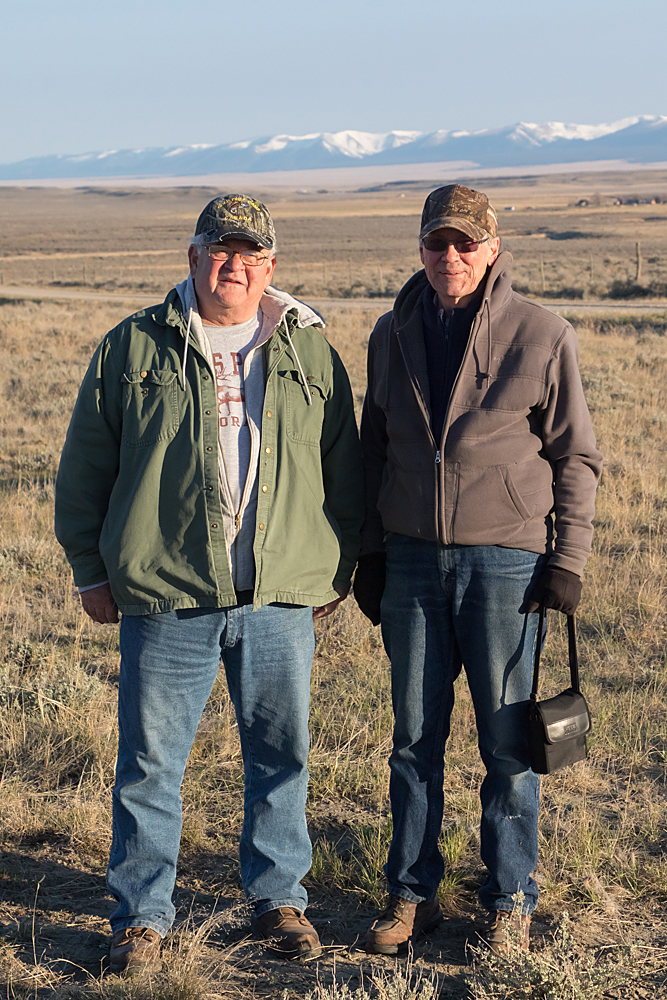
The old biologists: Rick Wallestad and Charlie Eustace -Photo courtesy of John Carlson
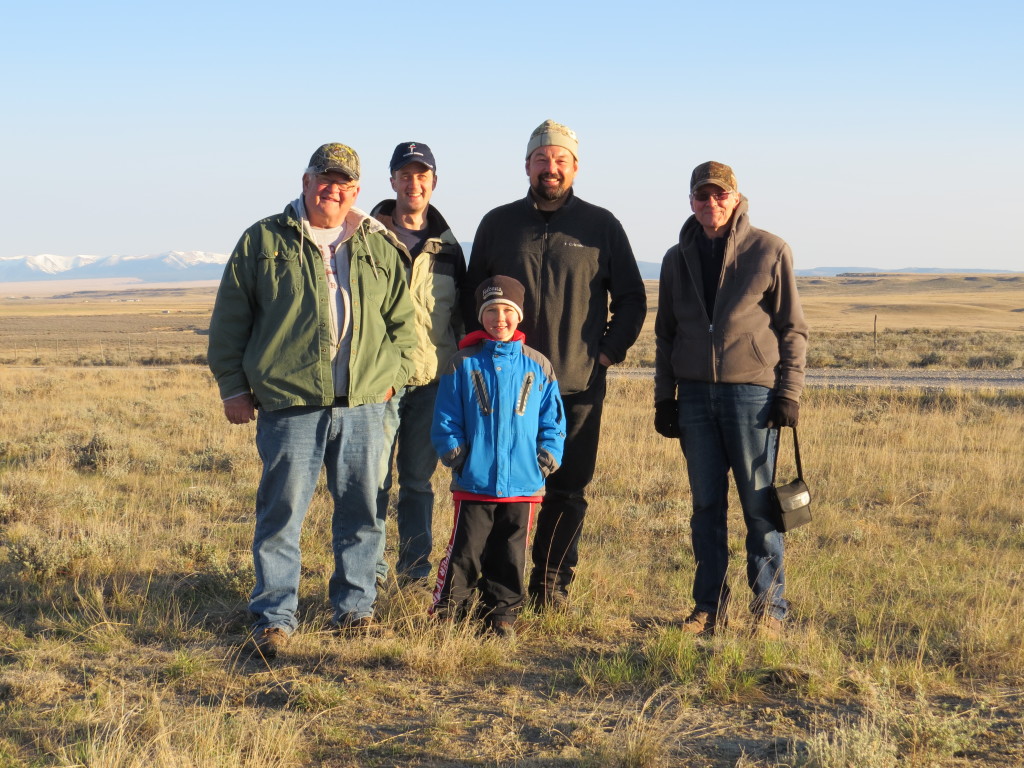
L-R: Dad, Me, Evan, John Carlson, Charlie Eustace
Since the day was still very young even though we’d been up for four hours, we went to the smaller lek on Emory Road that John had been viewing that morning to see if any of those birds were still around. On the way we dropped Charlie off at his car in Lavina and said our goodbyes to him.
As we cruised down Emory I was watching for Sage Thrashers when I was startled to see a few Greater Sage-Grouse in full display mode on the left side of the road. John told us we were very near the lek he was at, so these birds had probably just come from there. I was happy to have a second chance at photographing them.
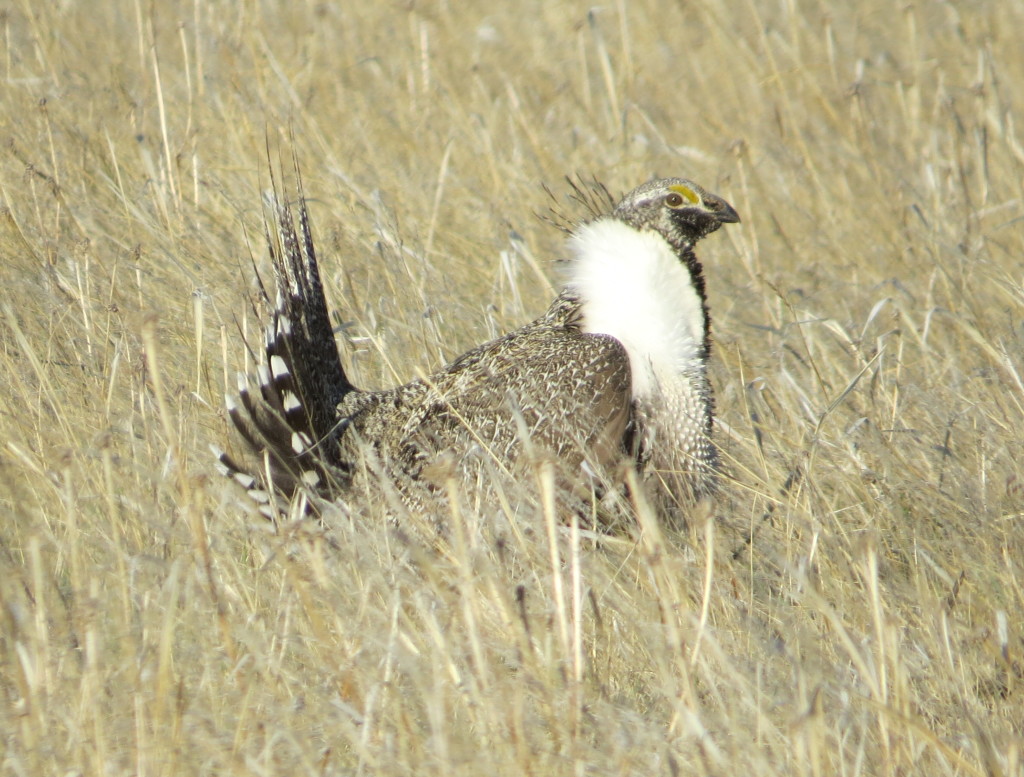
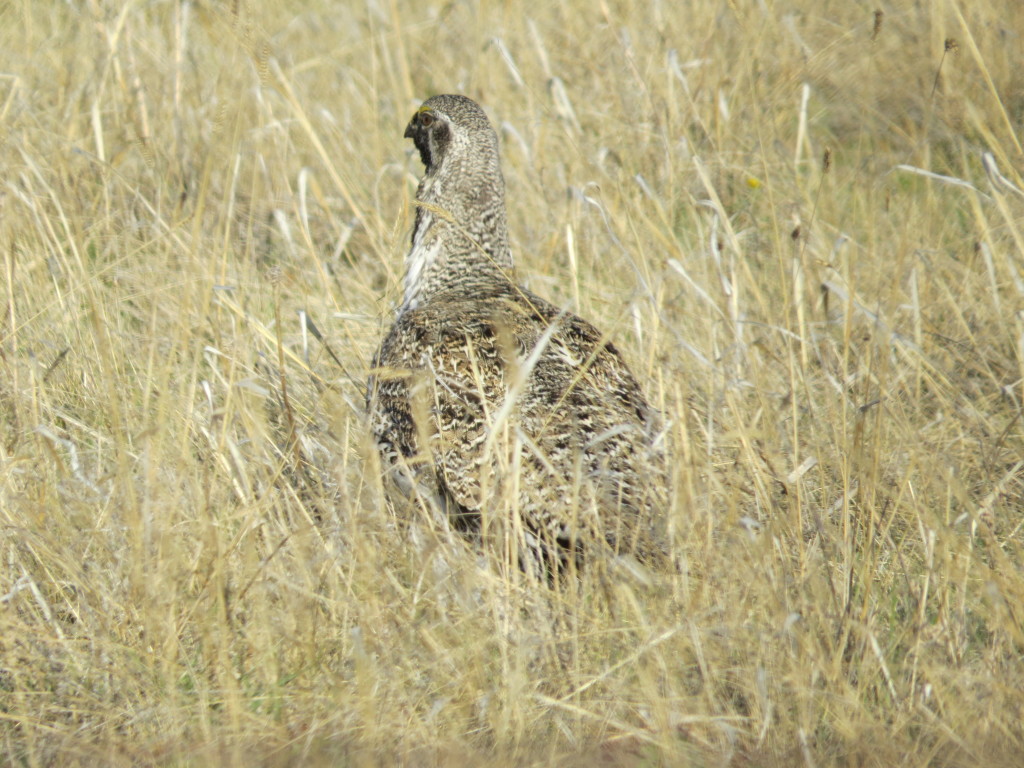
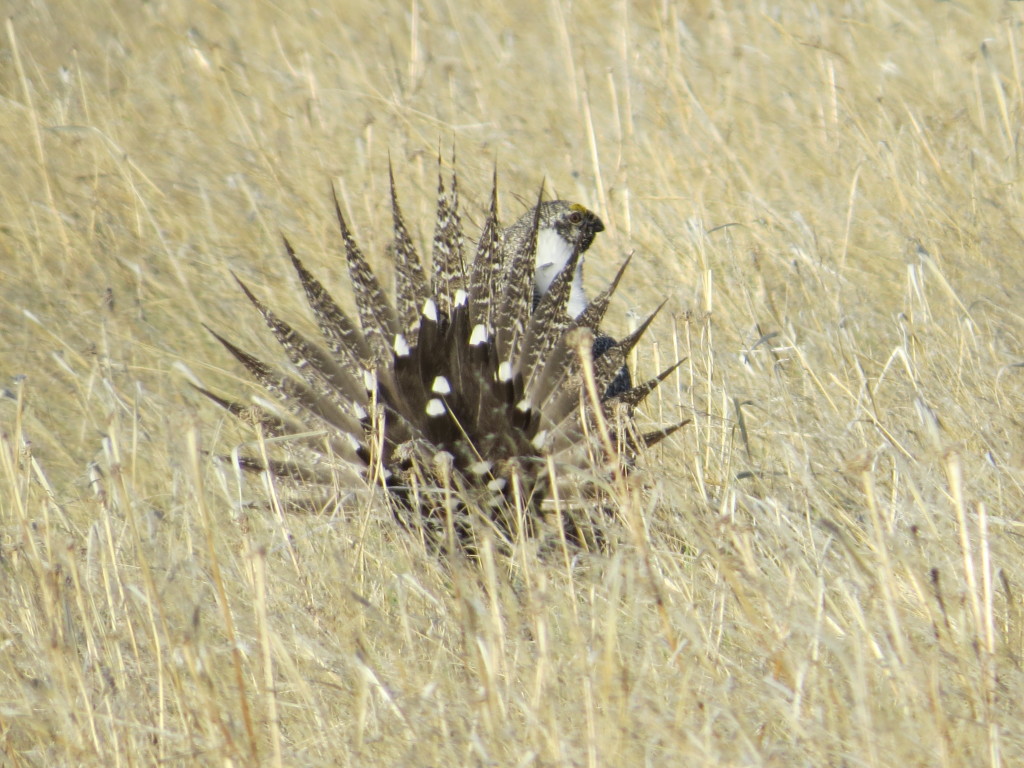
One of the protective efforts landowners and government agencies are taking to conserve Greater Sage-Grouse is to mark fences near active leks. When the Sage-Grouse fly into the lek in the pre-dawn, they have been known to be killed by collisions with barb-wire fences. John explained that these markers are meant to reflect the light from the rising sun, helping the Grouse see the fence and avoid hitting it. So, if you are out West in sagebrush country and you see these white markers, you are likely near a Greater Sage-Grouse lek. According to the pamphlet I picked up at the Montana FWP office, only fences in high-risk areas are marked, which is 6-14% of all fences in Sage-Grouse habitat. These marked fences can reduce collisions by 83%.
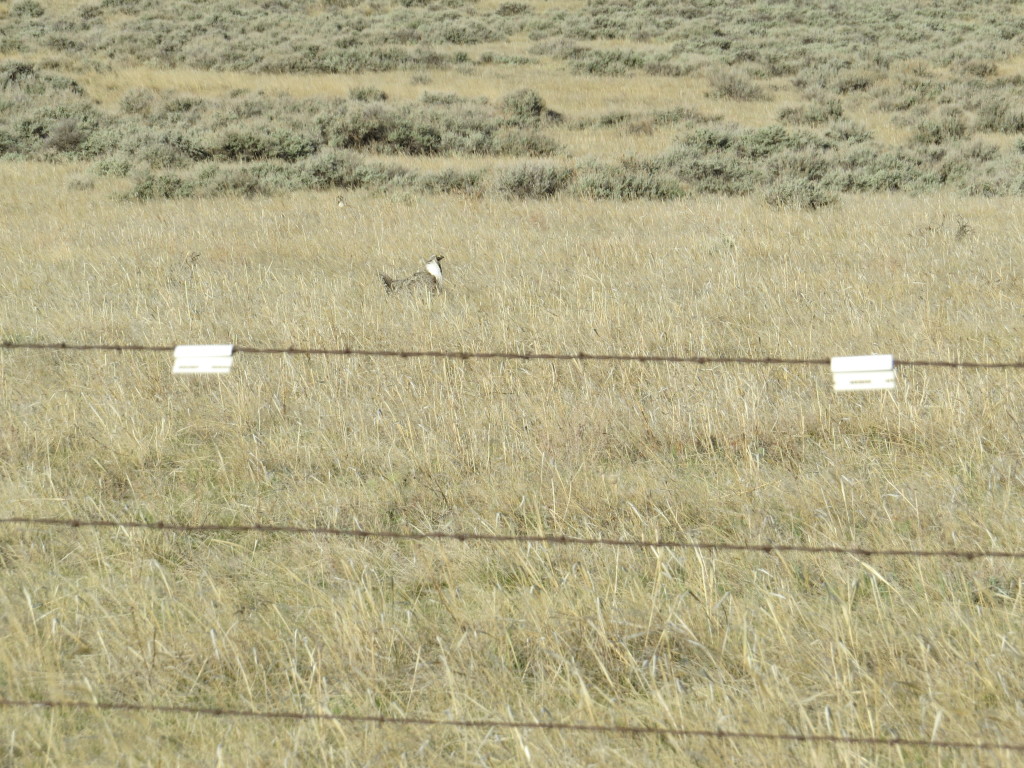
Fences in high-risk areas of Sage-Grouse habitat are marked to reduce collisions.
After enjoying these bonus Sage-Grouse for a bit as well as some other fun birds, we headed up to an area north of Roundup known as the Yellow Water Triangle. This is the area where Dad conducted his research on Greater Sage-Grouse in the 1970s. We were going to tour it and hopefully see some Sage-Grouse there as well, though it was getting to be too late in the morning for birds to still be on leks.
Dad brought one of his original maps along so he could point things out. It’s a pretty cool relic.
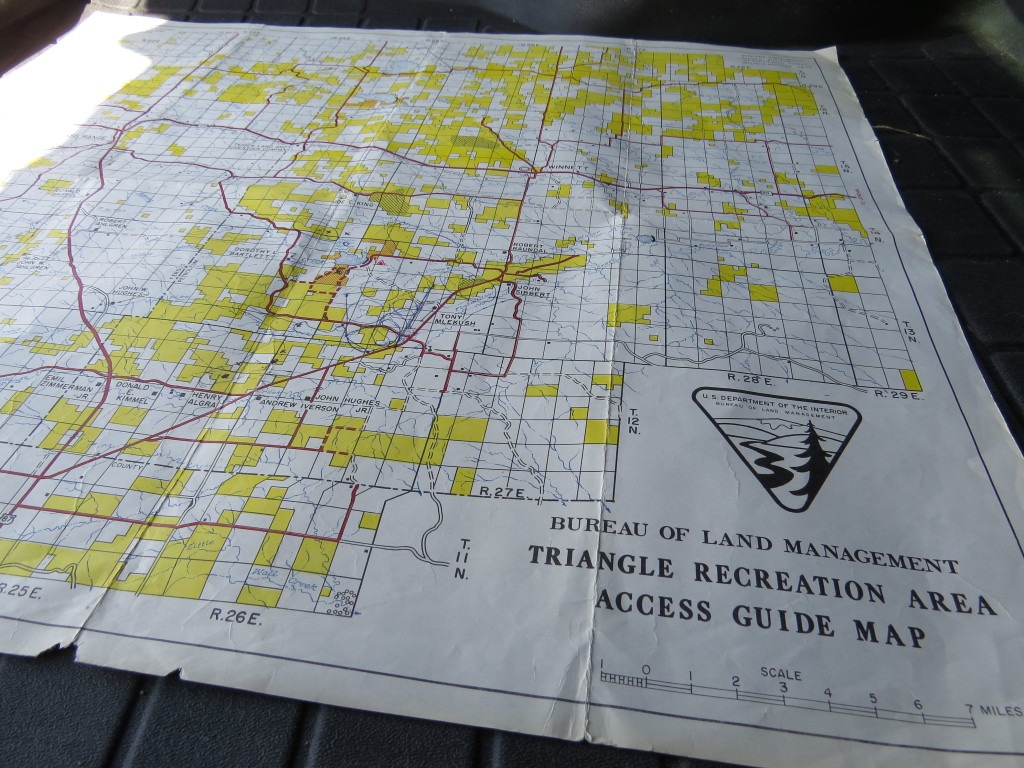 I believe the circles mark locations of leks, which Dad always called strutting grounds, that he knew of in the 1970s.
I believe the circles mark locations of leks, which Dad always called strutting grounds, that he knew of in the 1970s.
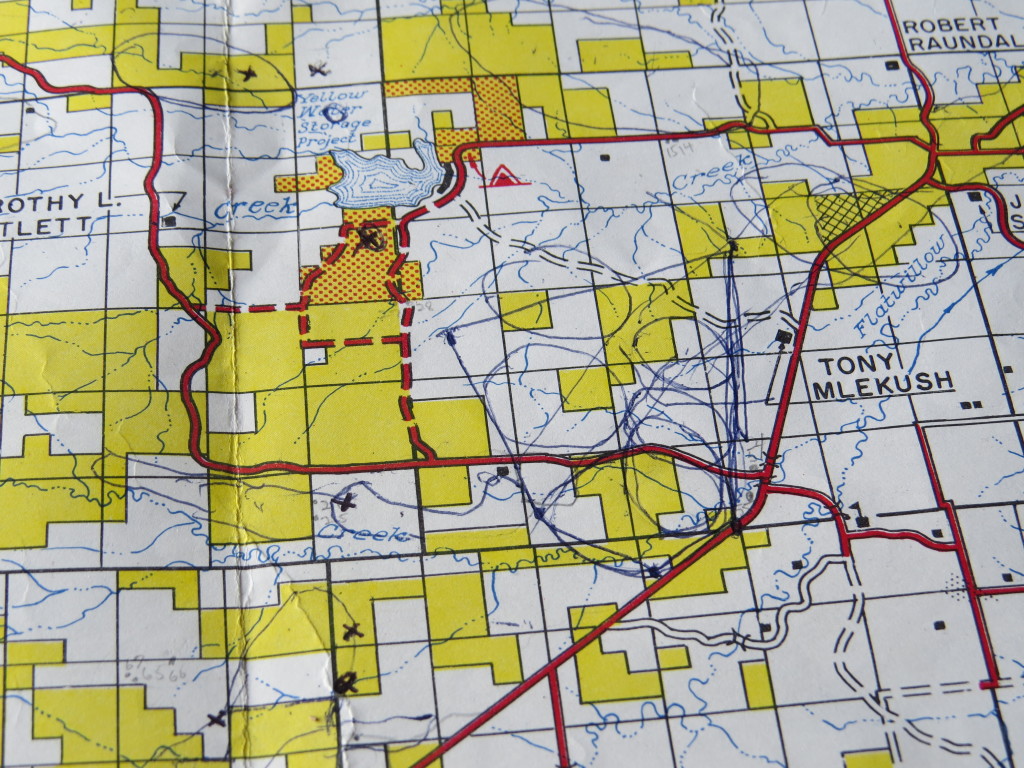
As we drove through the trails on the BLM land, Dad would tell us when we’d go by an area where he had a lek. Sure enough, the barb wire fences were marked with the white markers, meaning that birds are likely still using those grounds today, nearly 40 years after Dad worked in this area.
In retrospect I wish we would have taken more time to get out of the vehicle and explore some of these places, but the ferocious winds (40 mph!) were making for a miserable day for being outside and taking pictures. About the only picture I got of the landscape of the Yellow Water Triangle was in this picture I took of a buck Antelope.
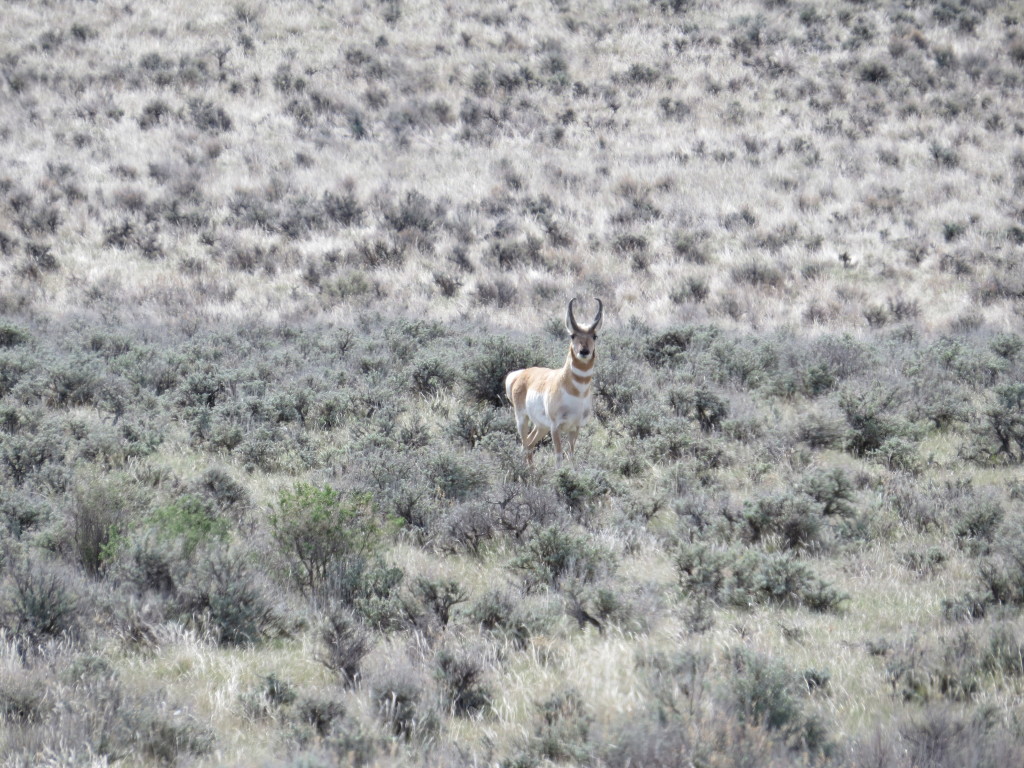
Pictures or not, it was nice to see this land where Dad spent so much time as a younger man than myself. He was my age when he left the Fish & Game for the entrepreneurial life. Now I at least have a frame of reference for the stories Dad has told and likely will retell. John Carlson told me later by email that he really enjoyed driving Dad through the Triangle and hearing his reactions to how the landscape has changed.
The rest of the day we continued to drive around central Montana on the quest for more life birds that are resident birds in this area. We were quite successful in that regard, but I’ll save all that for the epilogue to the Greater Sage-Grouse story. In reality, those birds were just icing on the best and most memorable bird trip we’ve done. I want to send out a huge thank you to John Carlson who facilitated the whole thing, making it an effortless and remarkable experience.
The Feather Story
When we were riding in John’s Suburban after our successful Sage-Grouse viewing, John gave Evan a special Sage-Grouse feather he found that morning. This feather is one of those black feathers with the white tips that you see on the back side of the fanned-tail. Several can be seen in the photos above. Evan cherished this gift from John, but like a typical 8 year-old, he wasn’t too careful about storing it in the vehicle. He’s usually pretty good about always knowing where his stuff is, so I didn’t think much of it.
Late that night, long after our 12-hour birding adventure was over, I was finally tucking Evan in to bed to get some sleep before our return trip the next day. It was at this time that he broke down sobbing telling me how at one point when we all had the windows down looking at birds, his special feather blew out the window (remember the 40 mph wind?). The kid was inconsolable.
That next morning I was planning to do some more Montana birding before we left for Bismarck where we’d again be spending the night. I was considering everything from looking for an American Dipper down at Red Lodge to going back to Lavina to try to get video of the Greater Sage Grouse–an opportunity I didn’t get because our time with the Grouse was cut short. Anyhow, when I heard Evan crying his heart out, I knew what I’d do. I’d head back to Lavina to view the Sage-Grouse and then go feather-hunting. I told Evan my plan, and it was the only thing that calmed him down.
I planned to go alone so Evan could sleep in. I didn’t expect my dad would be interested, but I was pleasantly surprised when he asked if I wanted company on the trip back to Lavina. A bonus was that Leo Jurica decided to join us too. So the three of us set off for the lek we viewed the day before. We got a later start this time since we didn’t have a blind we were trying to reach in the dark.
Getting there around 7:00 AM, there were still around 20 or so Greater Sage-Grouse males strutting on the lek. The views were considerably more distant this day since we were on the road. The Sage-Grouse are scattered across the middle of the photo, all the way from the left side to the right side. There are cattle in the background on the right.
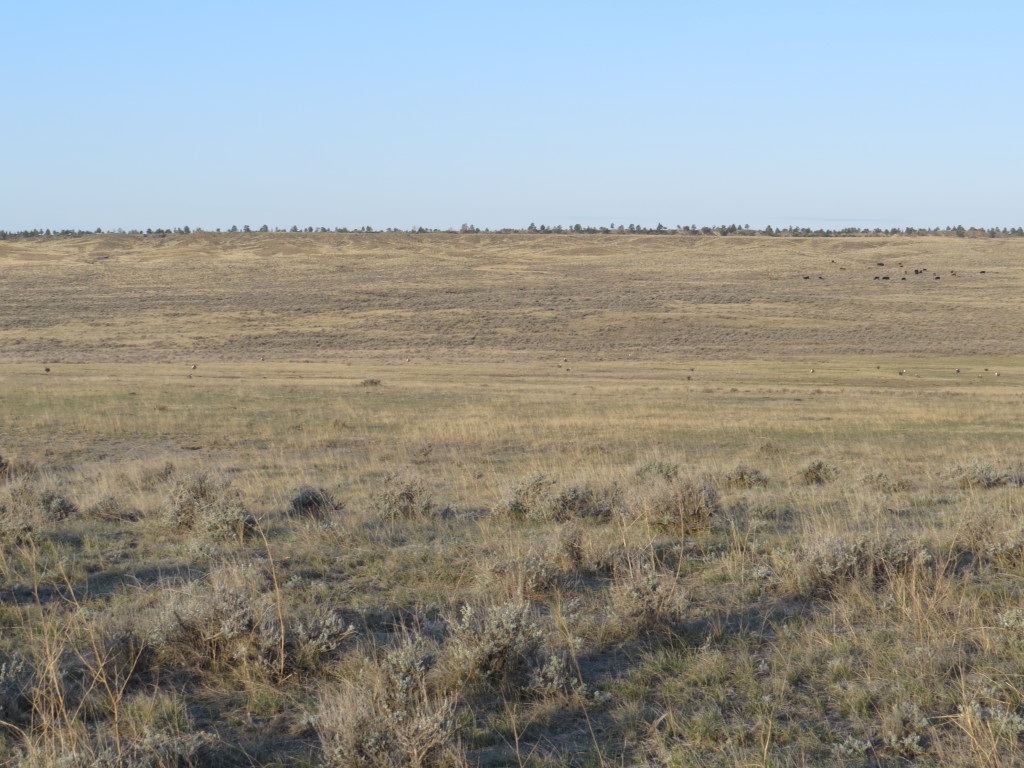
Though I wasn’t close enough for audio or the best video quality, I was able to document the very unique courtship display. This first video is an up-close look at two males doing their thing. Junior high boys or those that still think like them should not watch.
The next video shows a larger group of male Greater Sage-Grouse doing their strut.
Around 8:00, the birds started to disperse off the lek for the cover of sagebrush. Once they were gone, we went to work looking for a replacement feather for Evan. Apparently there were a couple of stragglers that popped out of the sagebrush on the periphery of the lek. I seized upon an unplanned photo opportunity that screamed out at me.
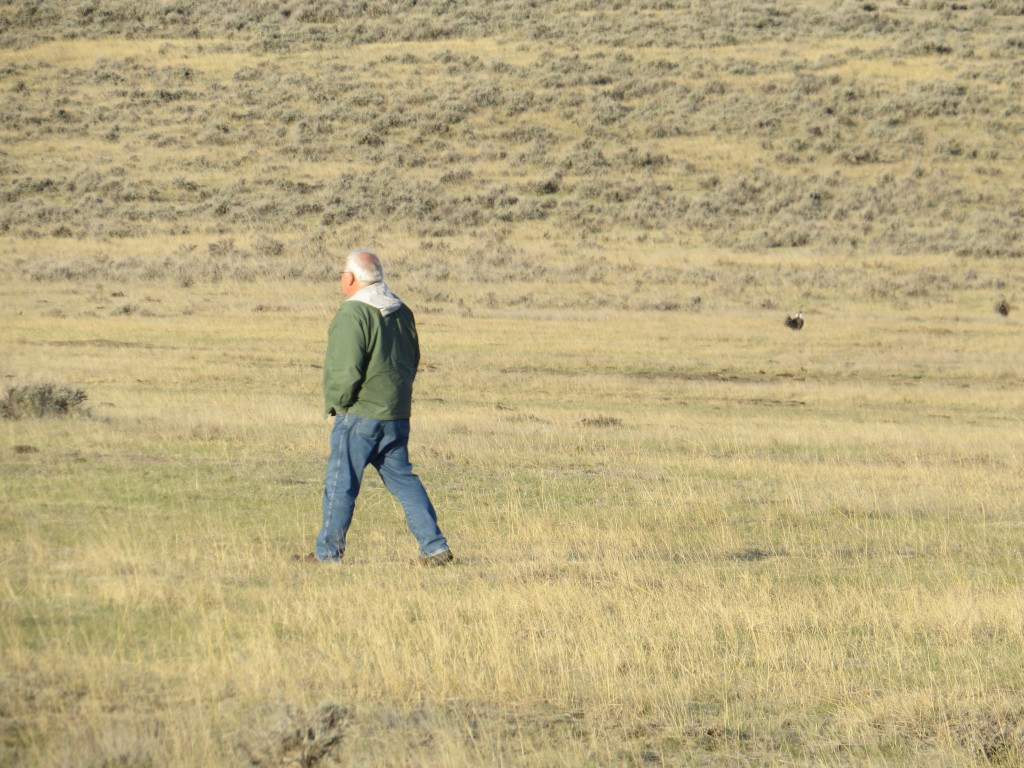 Seeing Sage-Grouse was unforgettable. Seeing them with Dad was even better. Now I had a photo of both together which I hadn’t planned but now cherish. Serendipity.
Seeing Sage-Grouse was unforgettable. Seeing them with Dad was even better. Now I had a photo of both together which I hadn’t planned but now cherish. Serendipity.
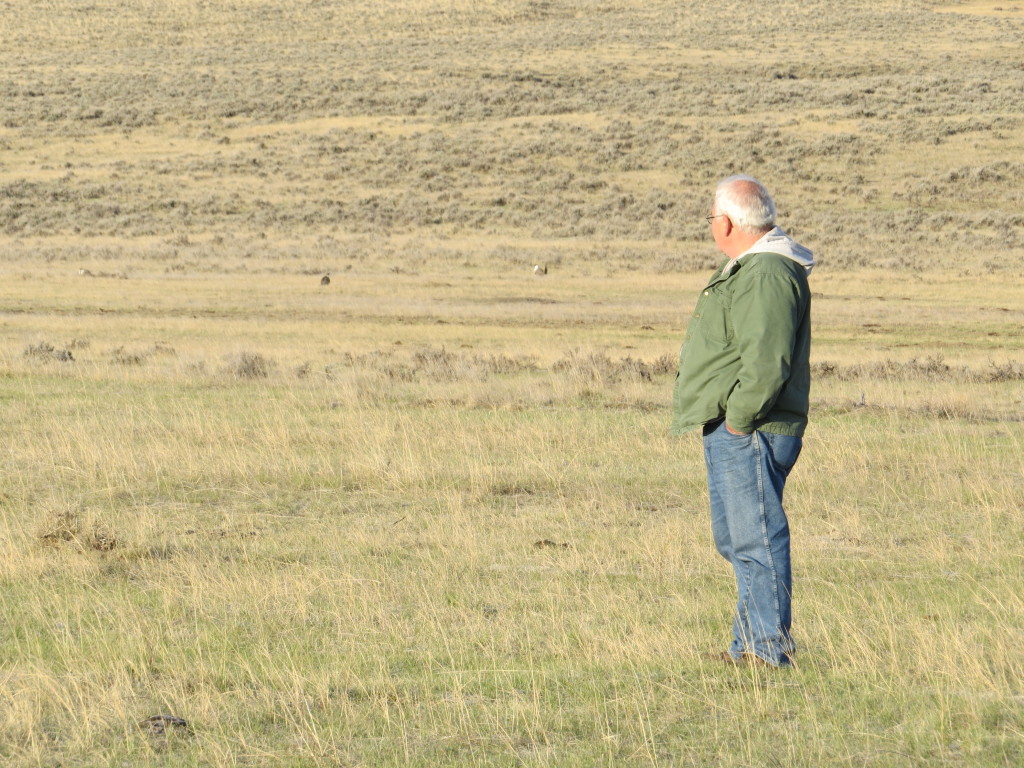 Back to the feather search, we looked and looked and looked. I foolishly thought the previous evening that this would be an easy task. Dad, Leo, and I combed the entire lek looking hard for one of those feathers. We were all dads and 2/3 of us were granddads, so we all searched with due diligence as we all understood how such a matter could make or break a kid’s day and trip. We went to ground-zero on the lek which is determined by the greatest concentration of bird droppings. We would find the occasional feather, but they were never the right feathers nor interesting ones for that matter either. Now finding a feather became something of a treasure hunt where the rarity of the feather enhanced its desirability. Despite our desire, we could not turn one up. We finally called it quits for searching at this lek.
Back to the feather search, we looked and looked and looked. I foolishly thought the previous evening that this would be an easy task. Dad, Leo, and I combed the entire lek looking hard for one of those feathers. We were all dads and 2/3 of us were granddads, so we all searched with due diligence as we all understood how such a matter could make or break a kid’s day and trip. We went to ground-zero on the lek which is determined by the greatest concentration of bird droppings. We would find the occasional feather, but they were never the right feathers nor interesting ones for that matter either. Now finding a feather became something of a treasure hunt where the rarity of the feather enhanced its desirability. Despite our desire, we could not turn one up. We finally called it quits for searching at this lek.
There was only one other option–to return to the lek on Emory Road where John found the original feather. There were no birds left on that lek by the time we got there. That was good because then we could start searching right away. This lek was smaller, and its ground-zero was even more concentrated with droppings. Again, there were oddball feathers, even a clump of feathers with skin attached from a Sage-Grouse brawl, but not the right feather. After a long time of searching but coming up empty, I was feeling really frustrated. How could it be so hard to find one of these feathers? I was just about to give up and was thinking I’d write to John to see if he could get me another, when I spied the object I sought, sticking straight up in the air with the quill stuck in a mud crack! I couldn’t believe it–this was as big a thrill as any rare bird I’ve found.
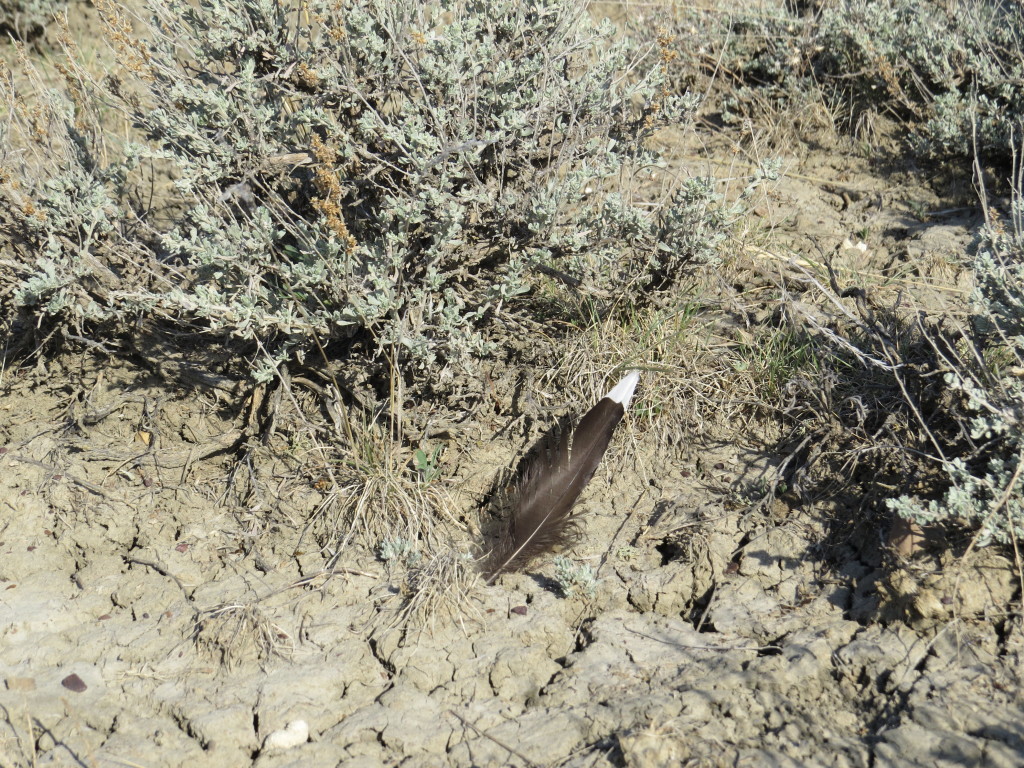
With the coveted feather in hand, we headed back to Billings. The Sage-Grouse saga truly was over now and was most fulfilling. As we pulled into the Juricas’ driveway, Evan was outside and ran up to the vehicle immediately asking, “Did you get it?!” Though it was something I already knew, the question revealed to Dad and Leo just how much this mattered to Evan. As dads we sometimes go the extra mile to make our kids’ wishes come true and make them happy….Thanks for the trip, Dad, and all the memories Evan and I will carry with us forever.
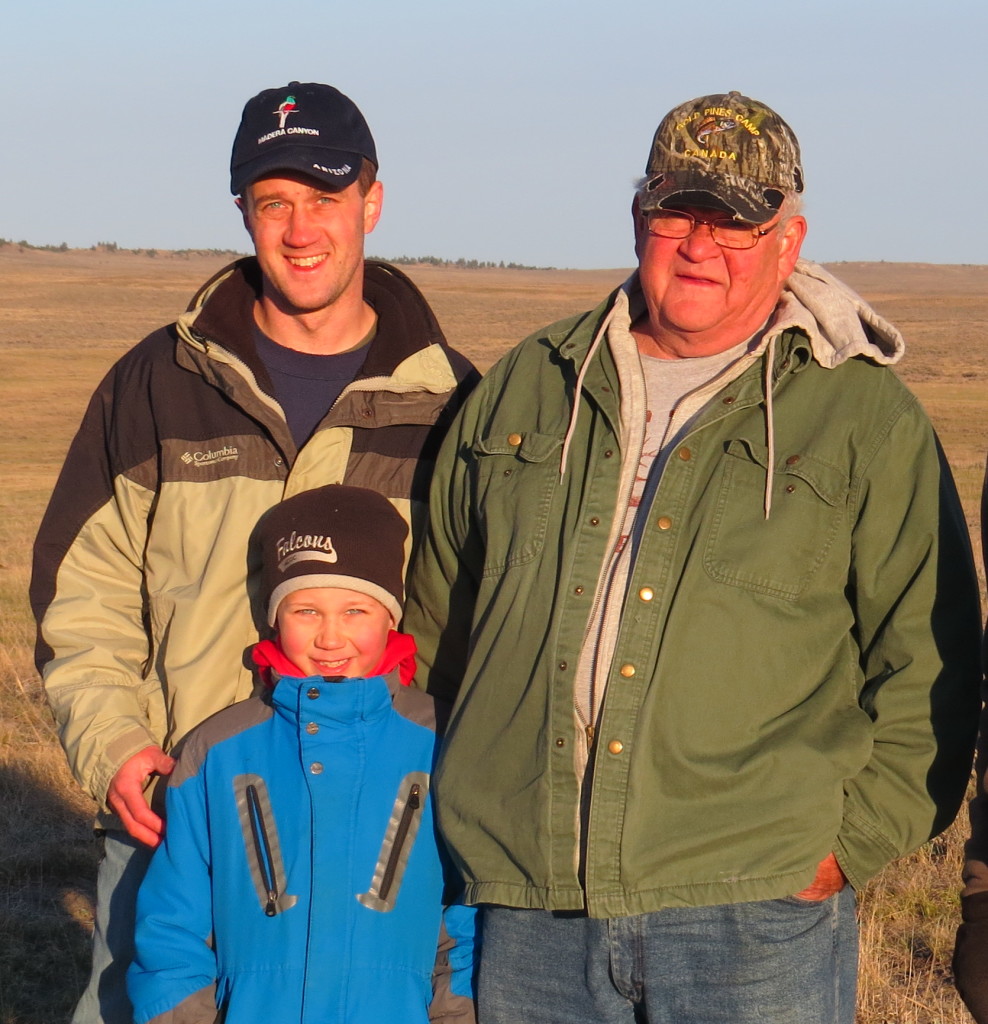 The story of our Montana Greater Sage-Grouse Lifer with Rick Wallestad is made up of four parts: 1) The Prologue–The Impetus, 2) Part 1, 3) Part 2, and 4) The Epilogue–Bonus Lifers.
The story of our Montana Greater Sage-Grouse Lifer with Rick Wallestad is made up of four parts: 1) The Prologue–The Impetus, 2) Part 1, 3) Part 2, and 4) The Epilogue–Bonus Lifers.

What a great story! We both sat here and read it on our iPads, chuckling over some details, being amazed at others. I’m glad the trip happened. It was great to share it with you and Evan.
I’m glad it finally became a reality too, Mom. It was great to have you along too on our grandest adventure!
Great trip and great Memories shared with the team, a new friend John Carlson, and old friends Charlie Eustace and Leo Jurica. Thanks Josh and John for making it happen. Thanks Evan for putting the excitement into the team and sharing your Dad’s passion for birding. Thanks Leo and Jo for your gracious hospitality in sharing your home with us.
The awesomeness of this trip was many layers deep, not the least of which was the Juricas’ outstanding hospitality. Looking forward to whatever new adventures, birds or otherwise, the Team gets into!
Josh:
Just finished reading Part 2 of Sage Grouse adventure. It was a REALLY great read and brought back memories of when I visited your Dad at the Yellowwater Triangle. And you were so fortunate to have the great guide that you had in John Carlson. Those memories will last forever!!
Always great to have you stop by, Bob. I couldn’t agree more on the lasting memories and the quality of our guide–John did an outstanding job, and it’s always a bonus to meet new birding friends!
I’m always longing to get back to Montana. Further exploration of the Triangle and birding with Bob may be in order next time.
That’s incredible! I’ve never seen so many in one photo (or, obviously, at all, in real life).
This series has been tremendous reading. Thank you!
My pleasure, Laurence. Yes! I couldn’t get over the numbers myself. I naively envisioned there would be just a few males on the lek, and at this location I did an eBird estimate of 75 birds in all, about 95% of which were males! The girls never really showed up in full force. It is insanely cool. Put it on your bucket list, man.
Great sage grouse story wallestads! I’ve been doing some gunnison sage grouse lek watching here in co this spring. Also, I’ve got a copy if ricks sage grouse book on my desk.
Scott
Thanks Scott, and nice to have you stop by! It sounds like you’re living the good life in CO.
I have decided that I now want to see all the Grouse species doing their courtship displays; there’s no better way! I might need to hit you up for advice on those Gunnisons someday and for finding Ruffed Grouse drumming logs up north.
Congrats Josh on a successful trip and for seeing these amazing birds! What an experience that it must have been. I think I’ll drop it in my bucket too for that good ol’ list.
It also must have been quite amazing to step foot on your Dad’s stepping grounds in his past biology career. I think it’s so awesome you guy sat in blinds and were able to watch those monsters. Someday I will want to experience it!
Thanks Tommy! Yes, by all means, save some room in the bucket for these guys.
I don’t think I have adequately explained just how cool it was to finally see where my dad worked and the amazing birds he studied.
How about we meet up halfway some spring for some Gunnisons in SW CO?!! You know I’m serious.
Josh, I’m loving the story of your trip to Billings and beyond. And so glad we got to see your mom and dad while they were here. Your dad worked for the Montana Fish & Game when we first met them in Winnett, but we never heard the tales of his experiences. We mostly played pinochle! They were wonderful neighbors!
I’m so excited to watch the videos you posted, however, Safari doesn’t allow me to do so. Do you know of a work-around, or can you send a different link?
Have a great day!
Sherry Thompson
Hi Sherry, I’m glad you enjoyed it and that you were able to reconnect with Mom and Dad because of the trip. That was another bonus for them. Dad takes his cards pretty seriously, so I’m sure that’s why he left work at work–I wouldn’t, I’d be telling everybody about these cool birds.
Maybe try opening Youtube in your browser and then do a search for my name along with ‘Greater Sage-Grouse’.